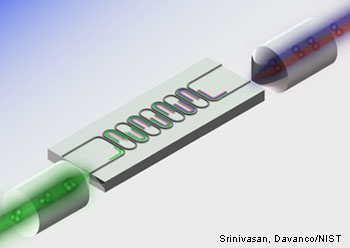
Illustration of photon pair generation in an integrated silicon device. An input pump beam in the NIR spontaneously generates special pairs of new photons that emerge at precisely the same time, with one at a slightly lower frequency and the other a slightly higher frequency. The presence of one photon in the pair indicates the existence (i.e., “heralds”) the other.
In a development that brings practical quantum computers closer to reality, a team of researchers demonstrated that they could create heralded single photons from a CMOS-compatible silicon chip operating at room temperature in the near-infrared (Appl Phys Lett 100, 261104). The work was a collaboration of researchers from the National Institute of Standards and Technology (NIST); University of California, San Diego; Politecnico di Milano in Italy; and the IBM Thomas J. Watson Research Center. This paper was one of three finalists in OSA’s Theodore Maiman Student Paper Competition.
Optical quantum computers can theoretically provide radically faster information processing than current technologies, but creating the technology to apply quantum photonics will require that all the necessary devices be integrated and compatible. Pairs of correlated photons are the basis for many quantum computing processes, so the ability to generate these pairs is important. With "heralded" photons, the existence of one photon is announced by the detection of its partner. Heralded pairs of photons could be used in the future to trigger the storage of information in quantum-based computer memories.
They designed the device to enable the nonlinear optical process of four-wave mixing in the silicon waveguide, and pump beam at 1549.6 nm to generate photon pairs at 1529.5 nm and 1570.5 nm.
The ability to create photons around 1550 nm eases integration with telecom fiberoptics and integrated photonics, while the use of silicon provides a relatively inexpensive substrate material and well-developed fabrication methods.
